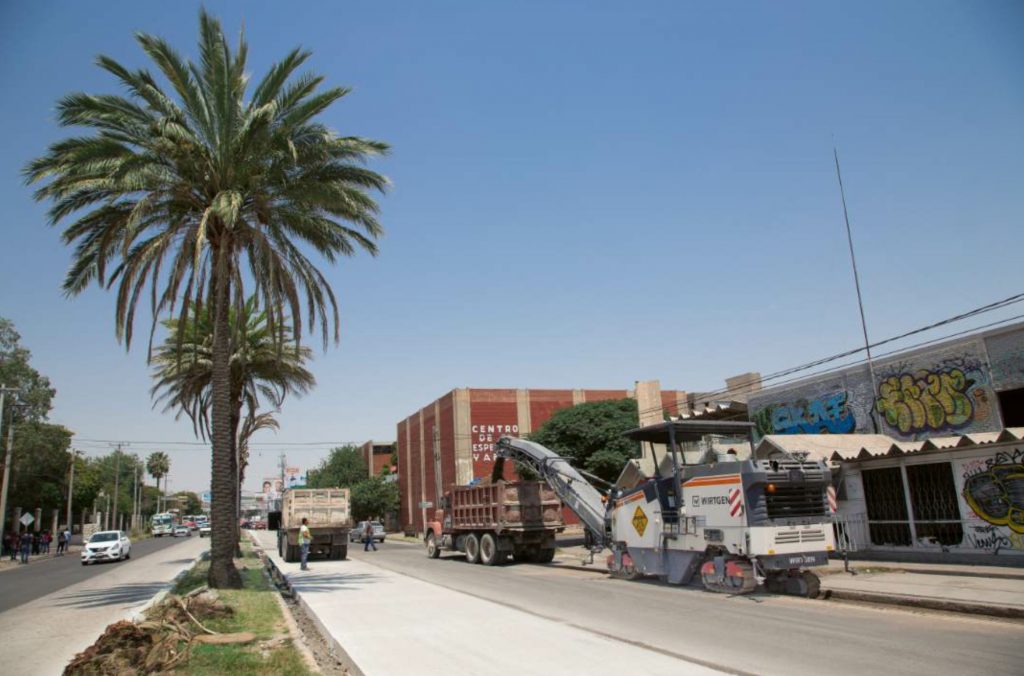TATSA Mills Torreon, Mexico, with Wirtgen
BY Tom Kuennen

In Torreón, Mexico, the pavement along the main urban road had to be removed so that a brand new Bus Rapid Transit (BRT) system can be implemented. The project in one of Mexico’s most important economic and industrial centres included a new, exclusive hydraulic concrete BRT lane plus the rehabilitation of two adjacent asphalt lanes. The project will result in better mobility, increasing traffic safety for city residents. However, before it could build the new lanes, milling contractor Triturados Asfalticos de Torreón S.A de C.V. (TATSA) faced the challenge of milling off the entire pavement at a maximum depth of 10 to 12 inches (25 to 30 centimeters).
Why Wirtgen’s W 150 CF Milling Machine?
The W 150 CF was capable of performing the milling work in one single pass, though TATSA sometimes milled off the pavement in two or three passes depending on the requirements of the respective stretch. “These roads are old and in the course of several years, they have been paved over many times without any milling work,” Engineer Gisela Gutiérrez explained. She’s the production coordinator at TATSA. “In some areas, the pavement is even above the level of the footpath.”

Simple transport let TATSA move the W 150 CF mill to various locations of the 5.8 miles (9.3 km) of inner-city lanes in Torreón.
The entire project covers a length of 15 miles (24.3 kilometers) and includes 5.8 miles (9.3 km) of inner-city lanes in Torreón and 9.3 miles (15 km) of highway between Torreón and Matamoros. The tender stipulated a single milling machine that could work at various locations in the city within the same day. To fulfil this specification and meet the demands of a large-scale project in confined spaces, the contractor chose Wirtgen’s W 150 CF with a 6-foot (1800-mm) milling drum assembly.
The W 150 CF can be swiftly relocated on the job site or between contract work sections with a travel speed of up to 4.6 mph (7.5 km/h). “Before participating in this tender, we talked to the applications experts from the Wirtgen Group dealer Construmac and soon agreed that the W 150 CF would be the best solution for this job,” the proprietor of TATSA, Engineer Ruben Tinoco, said. “The ordering authority agreed. After its arrival, the machine immediately convinced us. In the meantime, we have ordered a new model for further projects in Mexico.”

Minimize Disruptions, Get Results
Today, work on urban job sites must be completed much faster and more dynamically to minimize the impact on traffic, residents, workers and pedestrians. In Torreón, minimizing the disruption to traffic was an essential goal. According to Tinoco, the plan is similar to those he has seen applied on job sites in Europe. “I spent a holiday in Finland. At 6 p.m., a paving train composed of Wirtgen GROUP machines arrived in front of my hotel in Helsinki. The next morning when I got up, all the equipment was gone and the road was perfectly paved. We want our jobs in Mexico to be carried out just as quickly and efficiently, with minimal impact on traffic and to a high quality.”
To achieve optimum milling results, the W 150 CF offers levelling technology. When the surface course is removed, the Level Pro Plus levelling system continually compares the actual milling depth with the current target milling depth. Level Pro Plus is designed to work with a wide variety of sensors—cable, hydraulic cylinder, sonic and slope sensors, or laser and sonic ski sensors, as well as multiplex systems—and to be extended as required. 3D levelling is also possible thanks to integrated interfaces, which are compatible with 3D systems from common manufacturers.
In Torreón, TATSA used the multiplex system. With this system, three sensors on each side of the machine scan the height. The automatic levelling system factors all three measurements into its analysis so that the pre-set target milling depth is met exactly, while ensuring that any unevenness in the road surface is not copied.
“Working with the Wirtgen Level Pro Plus levelling system is intuitive and convenient; the result is an evenly milled, level surface,” Engineer Liborio Frias Estrada said. He was the coordinator for the BRT project in Torreón. “This is a crucial factor when it comes to paving the new surface courses and avoiding costly correction measures in the form of asphalt levelling courses.”
